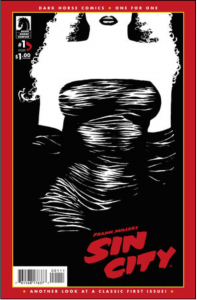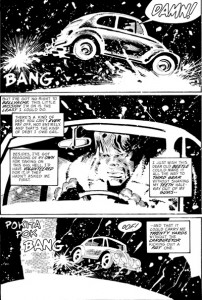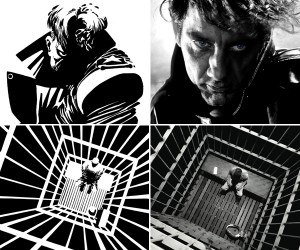American writer, artist and film director, Frank Miller, is most famously known for his work for Dark Horse comics where he wrote the graphic novels/comic books in the Sin City collection which famously have a dark, sinister feel.
A comic book is something that is very similar to reading a picture book. The words that make the story are accompanied by pictures which present the action taking place. The final product is a magazine filled with strips of action, segmented into smaller frames marking significant moments in the narrative. Comic books are unlike films, where all the action can be presented frame by frame. A comic book has to be selective, and is almost a story board of a narrative, hence each section of each strip is significant. That being said, when the producers decided to turn the comics into a film, the story board was half way done, and as that is essentially what a comic book is.
What I found so striking about Sin City was not only its film noir and style, but its narrative. Majority of mainstream films are written with one protagonist (or a duo), however, Sin City had several heroes and anti-heroes. There were a couple reoccurring characters, but depending on which comic book we were ‘watching’ the protagonist shifted accordingly. For instance, the starting sequence of the film provides the tone and presents us with two characters. Naturally, we assume they are main characters, but we quickly learn after 2 and a half minutes, that Josh Hartnett’s character is a hit man sent to kill the woman.
Immediately following this segment is the opening credits and we do not see Hartnett’s character again until the very last minutes of the movie. When the film returns after the opening sequence, we are introduced to Bruce Willis’ character. We know that he is now the protagonist as he is the voice narrating the sequence of events (when previously it was Josh Hartnett’s voice). The use of narration was a very important tool to help distinguish the different plot lines in a world where all characters co-exist in Basin City. Additionally, the film needed to be very visual about which characters are heroes which are anti heroes: ‘…every hero is a mentally or physically scarred bruiser and every woman is a beautiful dame with a heaving bosom.’ (tvtropes.org, 2015)
As Sin City is an anthology movie based on 7 of Frank Miller’s comic books, some of the plot lines overlap and weave together despite there being 5 very clear stories. The comic books are separate from one another despite their overlapping characters, and therefore the sequence of events in Sin City is muddled: Mickey Rourke’s dies at the end of his segment by electrocution in an electric chair, but later in Clive Owen’s story, he is alive and well sitting at a bar. For this reason, the time and place of the stories in Sin City is confusing but still works to create an interesting narrative as the ’emotional involvement [by the audience] is held by the glue of empathy’ (McKee 1997), and we are able to identify with each protagonist as he/she fights for what they want.
Films are generally directed by the one person, but in the instance of Sin City, there are three credited directors: Frank Miller, Quentin Tarantino and Robert Rodriguez. A director for the film is like the anchor: they make the executive decisions on how the film will progress. The idea that each director was in-charged of different segments of the film is not conventional, yet the subtle differences between the segments remain undetected because as an audience, we are too busy immersing ourselves in the characters of the next short lived story, detecting and identifying the visual and cinematic clues as to who is good and who is bad.
Prior to Sin City, the comic books existed as separate entertaining stories. Film allowed these characters to collide together, “mak[ing] its own unique contribution to the unfolding of the story” (Jenkins, 2007) due to simultaneous plot lines and a sense of how the characters relate to each other. As Frank Miller’s comics continue to expand through transmedia storytelling, there is now a video game and official soundtrack which continue to allow audiences to be immersed in Basin City and its seedy inhabitants even more.
Resources:
Manovich, Lev. (2001). ‘The database.’ In The language of new media.Cambridge, USA: The MIT Press, pp. 218-243.
McKee, Robert. (1997). ‘The Substance of Story.’ In Story: Style, Structure, Substance, and the Principles of Screenwriting.New York, USA: HarperCollins, pp. 135-154.
Phillips, Andrea. (2012). ‘What is transmedia, anyway?’ In Acreator’s guide to transmedia storytelling.New York, USA: McGraw-Hill, pp. 13-20.
Tvtropes.org,. ‘Sin City (Comic Book) – TV Tropes’. N.p., 2015. Web. 13 Mar. 2015.



